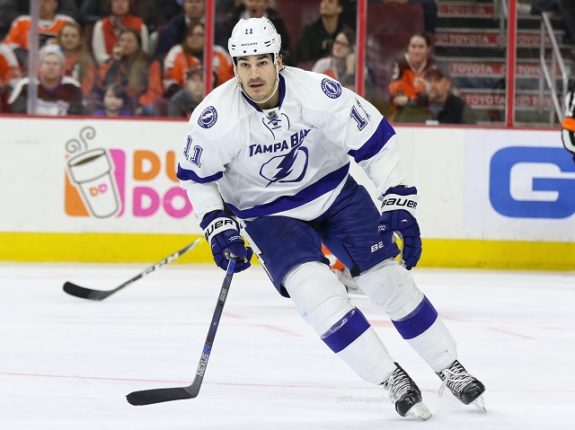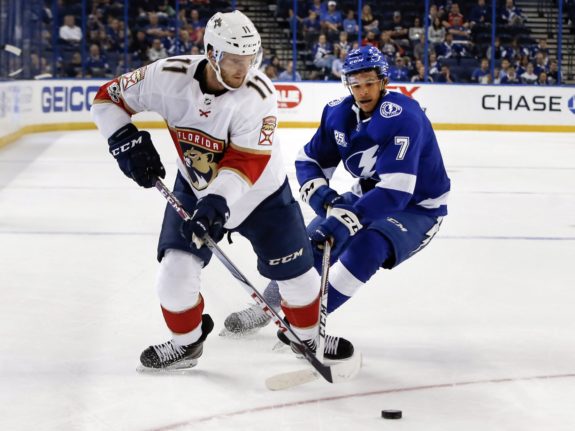What may have been lost in the Tampa Bay Lightning’s eight goal shellacking of the Columbus Blue Jackets on Oct. 13 was the dominance of the teams often maligned penalty kill. The unit went five for five on the night, keeping Columbus off the scoreboard at the most vital of times. This continued into their next game against the Carolina Hurricanes, where they went four for four while down a man and chipped in a shorthanded goal themselves.
In the past, the penalty kill was one of Tampa Bay’s biggest weaknesses, with the team having the 28th rank unit in the 2017-18 season. At points throughout the year, one couldn’t help but expect every penalty to result in a goal against.

In stark contrast, the Lightning sit at the top league right now, giving up no shorthanded goals through four games while scoring two. Yes, it is clearly far too early for statistics to matter, but the team has to be more than happy with their 100% successful penalty kill to start off the season. What’s more, this sudden improvement may be more than just a fluke, as the Lightning made a number of offseason changes to fix what was once the worst aspect of the team.
Coaching Changes Prompted Breakout Penalty Kill
Arguably, the biggest news to come out of the Lightning’s 2018 offseason was the team parting ways with associate head coach Rick Bowness after five years leading the defense and penalty kill. While he was a major part of the teams’ success since he signed on in 2013, their defense and special teams started to stagnate by the end of 2018 and throughout the playoffs. While Bowness will always have a place in Tampa Bay’s heart, there was a clear need for change after the team struggled to kill penalties at key times throughout the postseason.
Making an assistant coaching change jump-started a failing Lightning squad in the past, too. For example, after they had the 28th ranked power play in the 2015-16 season, they hired former Blue Jackets coach Todd Richards to revamp the ailing unit. Within two years, Richards had the power play humming, with the team scoring 23.9 percent of the time, good for third best in the league.
Jeff Halpern will work with #TBLightning forwards, be on the bench. Sounds like Todd Richards will handle the defense, which Bowness used to do. Not sure if another assistant is getting hired.
— Joe Smith (@JoeSmithNHL) June 22, 2018
After parting ways with Bowness, the Lightning looked internally and promoted Jeff Halpern, a former player and assistant coach from their AHL affiliate the Syracuse Crunch. Halpern would handle the forward corps, allowing Richards to take over the responsibility of fixing the other side of the Lightning’s special teams. Through four games, he seems to have worked his magic again, setting up a new defensive structure that gets the most out of his player’s abilities. This has not only helped reduce the Lightning’s overall goals against, but is a major contributor to their excellent penalty kill.
New Faces Earning Their Keep on the Penalty Kill
Speaking of players contributing in a special teams role, the Lightning have a handful of new faces who are factoring into their recent success while shorthanded. It starts with defenseman Ryan McDonagh, who seems to have fully embraced his role as a shut-down defender since being acquired at the 2018 deadline.
He is currently averaging more than five minutes a night on the kill, good for the second highest time on ice (TOI) while the Lightning are down a man. His steady play and ability to clear the puck alongside Anton Stralman is no small part to their perfect shorthanded record so far.

The player with the third highest TOI while down a man is rookie standout Anthony Cirelli. While Cirelli was able to carve out a niche role on the Lightning’s third line at the end of last season, he is already establishing himself as an invaluable member of the team’s penalty kill through four games. Not only did he score the teams’ first goal of the year while down a man, but he is also averaging close to two minutes more a night on the kill than the next forward on the list.
These new players, along with mainstays like Ondrej Palat, Tyler Johnson, Brayden Point, and Victor Hedman, have allowed the Lightning to produce a unit that is both defensively responsible while still able to exploit any mistakes made by the opposition. Even as a bad unit last year, they recorded nine shorthanded goals, good for a five-way tie for fifth in the league. Should they continue the pressure as they have so far, they could compete for the most shorthanded goals in the league this year.
Lightning Have to Build Upon Early Success
With such a strong start to the year on the penalty kill, there are a lot of positives for the Lightning to build on. Eventually, they will lose their pristine 100 percent success rate, but if they can reach even a fairly mediocre 80 percent success rate, it will be a major boon to the teams’ overall record this year.
Think about it this way. Last season, with one of the worst shorthanded units in the league, the Lightning still won the Atlantic division and had the third best record in the NHL. If they can improve to even a top-15 unit and continue scoring goals as they have in years past, this team will have no problem scraping together wins in the regular season. And, unlike last year, they will be able to do so without needing to score four goals every night.
This creates a new and exciting perspective for most Lightning fans. Suddenly, taking a penalty is not the end of the world. In fact, the Bolts may soon be able to lean on both their penalty kill and power play to make the plays that will win them the close games… something that they have been unable to do in years past.